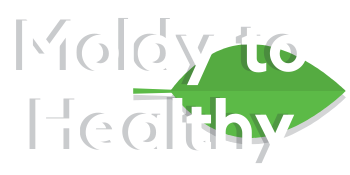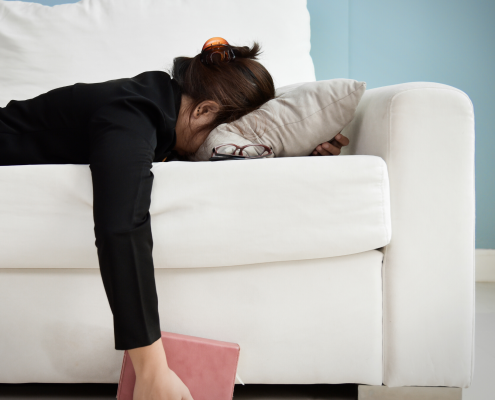Is It Fibromyalgia or Mold Illness?
by Sara Stapleton, MS-HNFM, L.Ac, Dipl. O.M.
Do you suspect you have fibromyalgia? Do you start your days stiff and in pain? Are you struggling with fatigue? Is brain fog making it hard to concentrate? Perhaps you’ve even visited with a long list of doctors and eventually ended up with a diagnosis. The challenge in determining whether someone has fibromyalgia lies in the fact that it relies solely on symptoms. There are no tests that can be run that will provide a definitive diagnosis. At best, the doctor can only rule out other disorders, like lupus, rheumatoid arthritis, mental health or neurological issues.
The current diagnostic criteria for fibromyalgia include:
- Widespread pain for at least three months, which the doctor will score on the Widespread Pain Index (WPI) across 19 specific areas.
- Presence of a list of approximately 40 other symptoms, such as waking up tired, low energy, poor concentration, numbness, anxiety, dizziness and stomach aches.
- No other underlying condition that may be responsible for these symptoms.
Based on that, making a definitive diagnosis requires a subjective leap of faith. If you or someone you love has been told they have fibromyalgia, then you understand how debilitating and life-changing it can be. It changes everything about the way you approach daily living.
The broad list of symptoms for fibromyalgia are really just symptoms of chronic inflammation, and the treatment (pain medications, antidepressants, anti-seizure drugs, physical therapy and counseling) is only designed to improve quality of life, not cure the problem.
What if your illness is caused by something most doctors aren’t currently trained to diagnose, and therefore, will almost always miss?
You may be one of the 25% of the population with a specific genetic variation that makes you vulnerable to Chronic Inflammatory Response Syndrome or CIRS (pronounced like ‘sirs’), and BY FAR the majority of the time it is caused by exposure to mold in a water-damaged building. This is why you’ll often hear it referred to as mold illness. You can also develop CIRS from toxins in a brown recluse spider bite, ciguatera toxin from eating tropical fish, the water borne toxins Pfiesteria and cyanobacteria, and from Borrelia burgdorferi which causes Lyme disease.
We call CIRS a multi-system, multi-symptom illness caused by generalized inflammation that is triggered by a hyper-reactive immune system that isn’t able to shut off. The good news is that it is a legitimate medical diagnosis that can be verified with specific lab tests and physical findings. And, even better, it can be treated and reversed, not just managed.
How do the symptoms of fibromyalgia and CIRS overlap?
When you experience a laundry list of symptoms across multiple organ systems, it’s hard to know what kind of doctor to see, so you end up at multiple different specialists’ offices trying to pin down a diagnosis. It’s a familiar story among people with overactive immune systems. The table below contains the symptom survey currently used to diagnose fibromyalgia. Each one of those symptoms can just as easily be associated with CIRS. What if some or all cases of fibromyalgia are just one of the presentations of CIRS?
Additional symptoms associated with CIRS include:
| Decreased assimilation of new knowledge | Memory Impairment |
| Decreased Word Finding | Difficulty Concentrating |
| A.M. Stiffness | Tearing of Eyes |
| Cough | Cramps |
| Red Eyes | Sense of Confusion |
| Sweats (Night) | Mood Swings |
| Difficulty Regulating Body Temperature | Metallic Taste |
| Static Shocks | Tremor |
| Excessive Thirst |
With CIRS, the symptoms are divided into 13 clusters, and we are looking for ≥13 of 37 symptoms across ≥8 clusters. The diagnosis must further be confirmed by ≥5 abnormal lab results. In other words, CIRS can be definitively diagnosed.
How do you know if you have CIRS rather than fibromyalgia?
Let’s start with some detective work. When was the last time you felt normal? When did things start going off the rails? Had you moved? Changed jobs? Are you aware of any water leaks in your home or workplace around that time you started having health issues?
Clue #1: Mold accounts for 80% of CIRS diagnoses, however it’s also worth noting if you’ve had Lyme disease or been bitten by a brown recluse spider in the past. Those can cause CIRS, as well.
All it takes for water damage to occur and toxic mold to grow is 48 hours of dampness from even a minor leak and a food source for mold, which is plentiful in our homes and offices. Any wood, carpet, drywall, furniture and most porous surfaces are perfect places for dangerous mold, mold fragments, bacteria and toxic mold by-products to hide. As a matter of fact, it’s estimated that 50% of buildings in the US have water damage, according to the Centers for Disease Control.
Sometimes we’re aware of water damage, and other times it’s hidden. Or, maybe you saw something that looked like it might have been a leak at one time, but it was dry, so you painted over it. That still counts. As a matter of fact, dead mold spores can be significantly more toxic than live ones, because they break apart into hundreds of tiny inflammatory particles (300-500 pieces PER SPORE) that we breathe deep into our lungs.
Bottom line: You may or may not be able to confirm whether you have been exposed to a water-damaged building. Just keep in mind that 50% of our buildings are water-damaged, and that often includes new construction, so your answer to the question will either be “Yes” or “I don’t know”. The important thing is that if you are currently being exposed, then the first step in recovery is to get out or fix the issue. Detecting and remediating mold is a whole different discussion. Just know that it might not be as bad as you think it is.
Clue #2: Are you genetically predisposed to CIRS? Twenty-five percent of the population has the genetic haplotype (DNA variation) that makes them prone to CIRS when exposed to mold in a water-damaged building. That means 82 million of us in the US have the genetic potential to develop CIRS. This is also the reason that mold may only affect one person in a family of four living in the same house, or one roommate in an apartment. People have the mistaken idea that if there’s mold, then everyone would get sick.
Clue #3: The symptoms cluster survey was discussed above. We are looking for 13 or more symptoms across 8 or more of the symptom clusters.
Clue #4: A total of 5 lab results must be abnormal. The biomarkers that are tested when CIRS is suspected are not commonly done in routine diagnostic exams. The good news is that we have tests we can run to confirm or rule out CIRS.
So, whether or not you can pinpoint being in a water-damaged building for any length of time, if you meet the criteria for the number of symptom clusters, and you have five or more positive lab results, then congratulations! You’ve solved the case! It’s not fibromyalgia after all!
Even better news? CIRS can be treated and reversed, so you won’t spend the rest of your life just managing symptoms. Dr. Ritchie Shoemaker has dedicated his career to studying CIRS. His treatment protocol is the only one to date that is supported by scientific data and proven to resolve CIRS. Even grey matter brain atrophy can be reversed, so that constant brain fog will go away!
A word of caution: If you start “Googling” mold illness and CIRS, you will find no shortage of practitioners who claim to treat it. While the vast majority of them are well-intentioned and highly respectable, Dr. Shoemaker’s protocol is the only one that has been scientifically and clinically proven in research as effective at correcting the out-of-control immune system and restoring health in patients with mold illness.
Imagine waking up in the morning feeling refreshed, without pain and able to easily stand. Imagine being able to move freely. Imagine having energy and the ability to concentrate at work. Imagine reclaiming the person you once were and enjoying life.
If you have been diagnosed with fibromyalgia or are experiencing symptoms of CIRS/mold illness, click on this link for Moldy to Healthy and receive a free PDF filled with information. You can also reach out to us at Merritt Wellness to meet with any of our Shoemaker trained practitioners.






